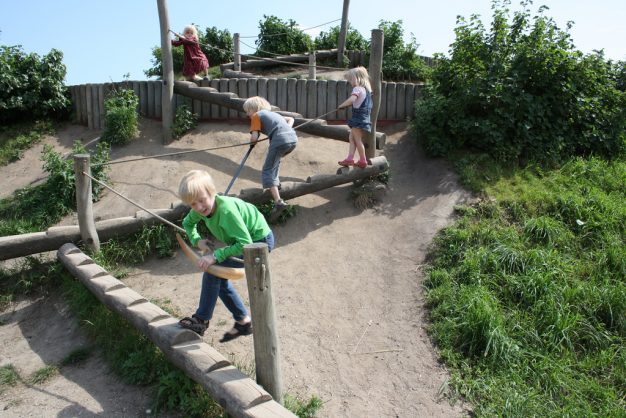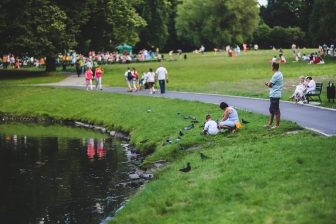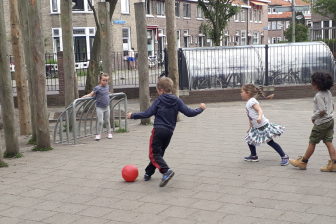
Natural space trains children’s mind
In northern European cities, there is a large number of wild and adventure playgrounds, where children can learn from nature and from their personal experiences. There are playgrounds planned in a way to stimulate an interest in art, or others that mimic the ambience of electronic games.
Researches show that children need an outdoor education. The natural world stimulates their curiosity and creativity and encourages cooperation between them, in order to overcome the obstacles and dangers. Children will be prepared enough for real life situations if their play develops risk awareness; therefore, the goal is not to eliminate risks, but to be able to manage them. Children will not learn that the world is full of risk if they are constantly wrapped in cotton wool. Playgrounds with risk-embedded design can help children to become responsible and achieve higher self-control.
Valbyparken
One good example is Copenhagen, where there are more than 125 playgrounds, for children of all ages. Helle Nebelong, a Danish landscape architect, designed a 20.000 m² playground called Valbyparken that offers a pristine landscape, full of biodiversity, where children can really explore nature. This playground originated from an old rubbish tip.
Today, Valbyparken offers to children a playing experience close to nature. In fact the area is characterised by hills, a big sandy area, water holes and a village of wooden huts. Elements, like earth, water, grass, branches and stones are at children’s disposal; through the use of these natural elements, they give shape to their world, stimulating their fantasies. When children familiarise with the space they have more self-esteem, since they are able to realise something concrete. Moreover, there is no place that cannot be changed by children’s imaginations. Exploring the nature world trains children’s mind to create new things by learning from what they see.
How the playground affects children’s behaviour
Observations of children’s behaviour at playgrounds shows that they tend to follow traditional activities for not more than ten minutes at a time. In contrast, in an adventure-type playground or wild play garden, their playing occupies their attention for longer, sustained periods.
An adventure playground, which may allow children to prove themselves and to learn from their experiences or mistakes, is characterised in particular by the presence of natural elements; there may be tall grass, even if it hides traps; there may be prickly plants or nettles, because only in this way will children be able to recognise them; and also, there will be hills and climbs, allowing to children to hide, even if parents cannot always control their children because of the slopes.
Typical playgrounds may never have these features. As Helle Nebelong, the Danish landscape architect, passionate about designing spaces for children, affirmed: “I am convinced that standardised playgrounds are dangerous, just in another way: when the distance between all the rungs in a climbing net or a ladder is exactly the same, the child has no need to concentrate on where he puts his feet. Standardisation is dangerous because play becomes simplified and the child does not have to worry about his movements”.
Should kids play alone, despite the risks?
While it is a modern trend that risk anxiety and excessive parental supervision are constraining children’s play, the importance of risky outdoor play has been recognised in several studies. In fact, Ellen Sangster, a psychologist in the University of Trondheim (and the mother of two children) affirmed: “The obsession with safety has spiralled out of control”. She supports the view that risky play is important for children’s growth, and encountering risks can have important benefits.
According to her research, after observing playgrounds in Norway, Australia and England, children, even in early childhood, are able to evaluate risks and to solve difficult situations in appropriate ways. “Very few children climb right to the top the first time” but, step by step, they reach a higher level of risk, some rapidly, some more slowly. Kids are not so afraid to fall, but rather more worried about the anxieties of their parents. If they are denied the opportunity to deal with risks as kids, she believes, children will not grow up with the confidence or courage to effectively manage real life.
Through risky play: muscles strengthen; the sense of balance improves; and children develop their self-esteem and conquer their fears. “From birth all children have fears, such as of heights or deep water. What is decisive is whether they get used to it through natural behaviour such as climbing, and recognise that they don’t have to be afraid”.
Author: Chiara Carlucci
Architect & Urbanist
Photo Credit: Photo by Peter Ravn Rasmussen (https://www.flickr.com/photos/peterravnrasmussen/5824999786/)
References:
_A. Pecoriello, Il campo giochi d’avventura, in “Il Barrito del Mammut”, anno II, n.3, may 2009.
_A. Frey, Don’t just wrap in cotton wool, in: “Playground@Landscape, International trade journal for play, sports and leisure areas”, June 2011.
_http://www.sansehaver.dk/asp/side/naturlegepladsen.html#engelsk
_http://www.sansehaver.dk/asp/side/english.html
_http://international.kk.dk/artikel/children?nm_extag=et%2Clink%2CLinkPane%2C%20Children




